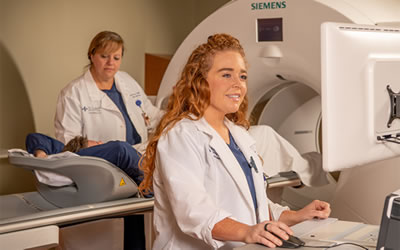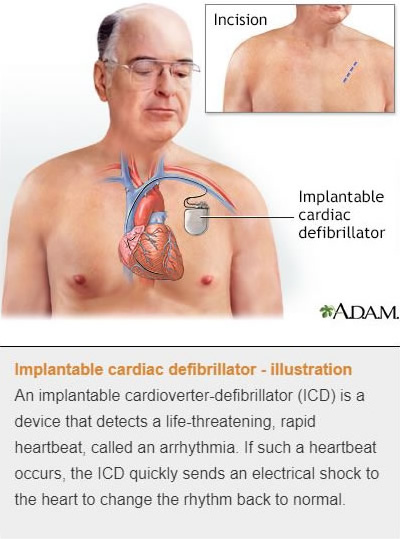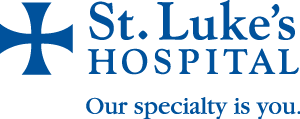Hypertrophic Cardiomyopathy
Diagnosis and Treatment
About Hypertrophic
Cardiomyopathy Risk Factors
and Screening Meet Your HCM Team/
Request an Appointment Find a St. Luke's
Cardiologist
 Diagnostic Tests
Diagnostic Tests
Diagnosis is typically done by echocardiogram. It checks the thickness of the heart muscle and blood flow from the heart. In some cases, another type of echocardiogram, transesophageal echo (or TEE), may be performed. A TEE is done using a probe inserted in the throat while the patient is under sedation.
Other diagnostic tests may include:
Confirming diagnosis or preparing for surgery may also involve one or more medical procedures including:
Medications
Medications are often prescribed to treat symptoms and prevent further complications. Medications such as beta blockers and calcium channel blockers relax the heart muscle, allowing it to fill better and pump more effectively. Other medications may be prescribed as needed to control your heart rate or decrease the occurrence of arrhythmias.
You may be told to avoid certain medications, such as nitrates, because they lower blood pressure, or digoxin, because it increases the force of the heart's contraction. IC
 Procedures
Procedures
A range of surgical and nonsurgical procedures can be used to treat HCM:
Cardiomyopathy Risk Factors
and Screening Meet Your HCM Team/
Request an Appointment Find a St. Luke's
Cardiologist
Hypertrophic cardiomyopathy (HCM) is most often inherited. HCM is the most common form of genetic heart disease. It can happen at any age, but most receive a diagnosis in middle age.
According to the American Heart Association, it's estimated that 1 in every 500 people have HCM, but a large percentage of patients are undiagnosed.
HCM is diagnosed based on your medical history, family history, a physical exam and diagnostic test results. Knowing your medical history and any signs and symptoms you may have is an important first step. Your physician will also want to know if anyone in your family has been diagnosed with HCM, heart failure, or cardiac arrest.
According to the American Heart Association, it's estimated that 1 in every 500 people have HCM, but a large percentage of patients are undiagnosed.
HCM is diagnosed based on your medical history, family history, a physical exam and diagnostic test results. Knowing your medical history and any signs and symptoms you may have is an important first step. Your physician will also want to know if anyone in your family has been diagnosed with HCM, heart failure, or cardiac arrest.
 Diagnostic Tests
Diagnostic Tests
Diagnosis is typically done by echocardiogram. It checks the thickness of the heart muscle and blood flow from the heart. In some cases, another type of echocardiogram, transesophageal echo (or TEE), may be performed. A TEE is done using a probe inserted in the throat while the patient is under sedation.
Other diagnostic tests may include:
- Electrocardiogram (ECG)
- Cardiac MRI
- Myocardial Perfusion Imaging
- Stress tests: Exercise stress test, Nuclear stress test, Stress echocardiogram
- Holter and event monitors
- Genetic testing
Confirming diagnosis or preparing for surgery may also involve one or more medical procedures including:
Treatment and Management of HCM
Treatment is provided an individualized basis. Various options, depending on the severity of the condition, include monitoring, medications and specialized surgery which resects or removes the muscle tissue that may be obstructing the heart function.
For people with HCM who don't have symptoms, lifestyle changes and medications for conditions that may contribute to cardiovascular disease are recommended.
For those with symptoms, the focus is on symptom management using medications and procedures.
Treatment is provided an individualized basis. Various options, depending on the severity of the condition, include monitoring, medications and specialized surgery which resects or removes the muscle tissue that may be obstructing the heart function.
For people with HCM who don't have symptoms, lifestyle changes and medications for conditions that may contribute to cardiovascular disease are recommended.
For those with symptoms, the focus is on symptom management using medications and procedures.
Medications
Medications are often prescribed to treat symptoms and prevent further complications. Medications such as beta blockers and calcium channel blockers relax the heart muscle, allowing it to fill better and pump more effectively. Other medications may be prescribed as needed to control your heart rate or decrease the occurrence of arrhythmias.
You may be told to avoid certain medications, such as nitrates, because they lower blood pressure, or digoxin, because it increases the force of the heart's contraction. IC
 Procedures
Procedures
A range of surgical and nonsurgical procedures can be used to treat HCM:
- Septal myectomy - Septal myectomy is open-heart surgery. It's considered for people with obstructive HCM and severe symptoms. This surgery is generally reserved for younger patients and for people whose medications aren't working well. A surgeon removes part of the thickened septum that's bulging into the left ventricle. This improves blood flow within the heart and out to the body.
- Alcohol septal ablation (nonsurgical procedure) - This procedure is reserved for patients who are not eligible candidates for septal myectomy. The ablation procedure is performed in the cardiac catheterization laboratory. In this procedure, ethanol (a type of alcohol) is injected through a tube into the small artery that supplies blood to the area of heart muscle thickened by HCM. The alcohol causes these cells to die. The thickened tissue shrinks to a more normal size. The risks and complications of heart surgery increase with age. For this reason, ablation may be preferred to myectomy in older patients with other medical conditions.
- Surgically implanted devices - Surgeons can implant several types of devices to help the heart work better, including:
- Implantable cardioverter defibrillator (ICD) - An ICD helps maintain a normal heartbeat by sending an electric shock to the heart if an irregular heartbeat is detected. This reduces the risk of sudden cardiac death.
- Pacemaker - This small device uses electrical pulses to prompt the heart to beat at a normal rate.
- Cardiac resynchronization therapy (CRT) device - This device coordinates contractions between the heart's left and right ventricles.
- Heart transplant - In HCM patients with advanced, end-stage disease, a heart transplant may be considered. In this procedure, a person's diseased heart is replaced with a healthy donor heart.

